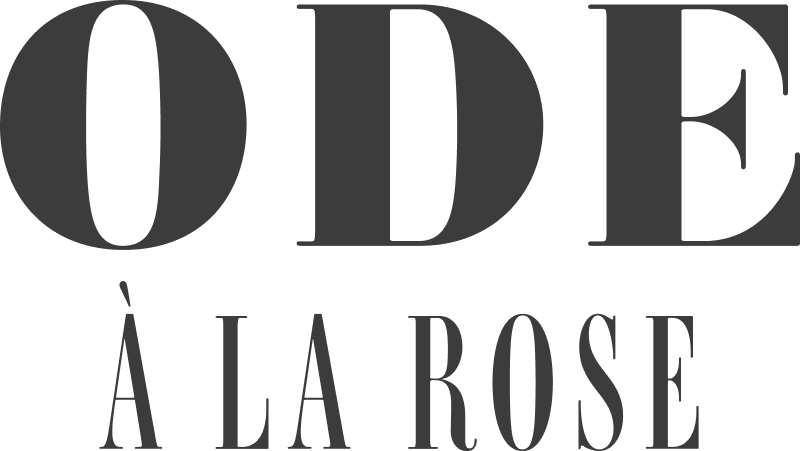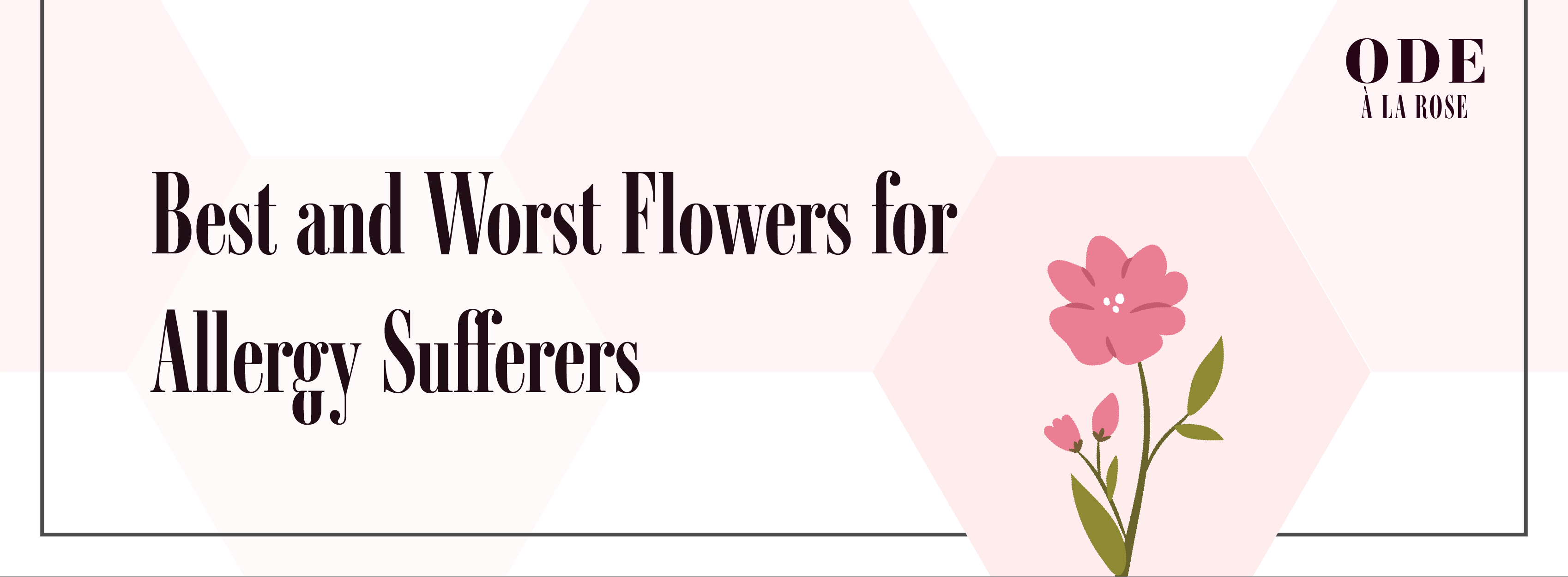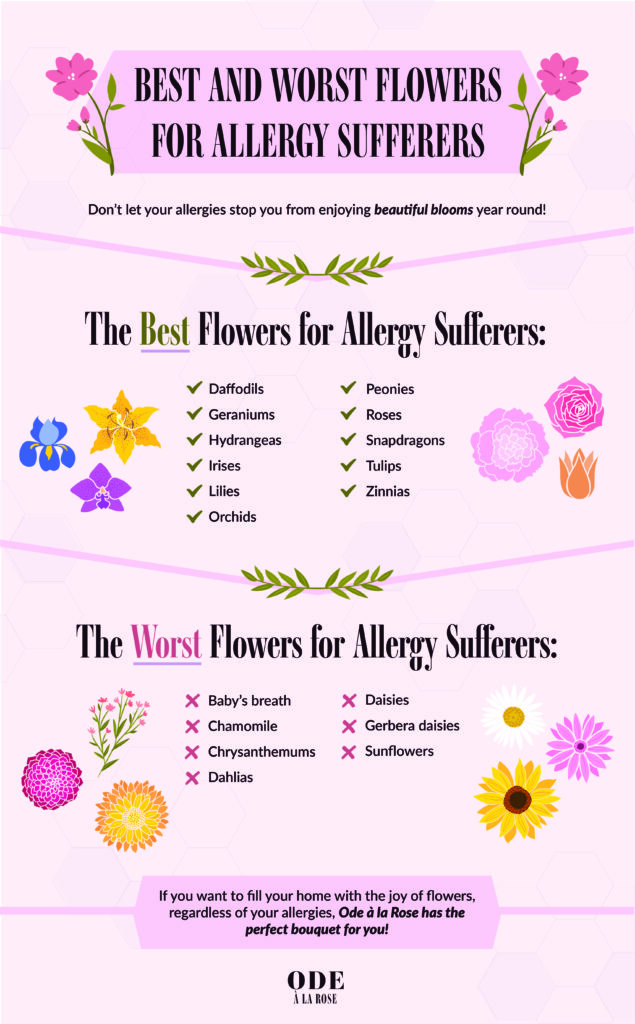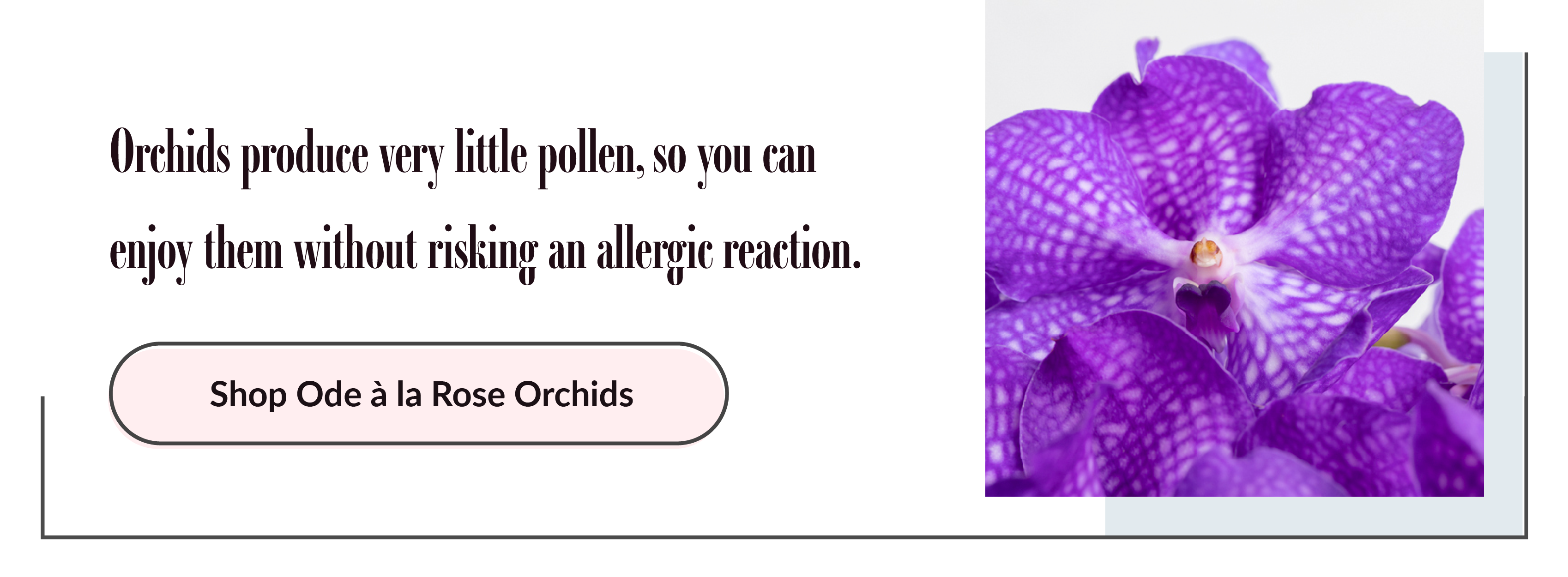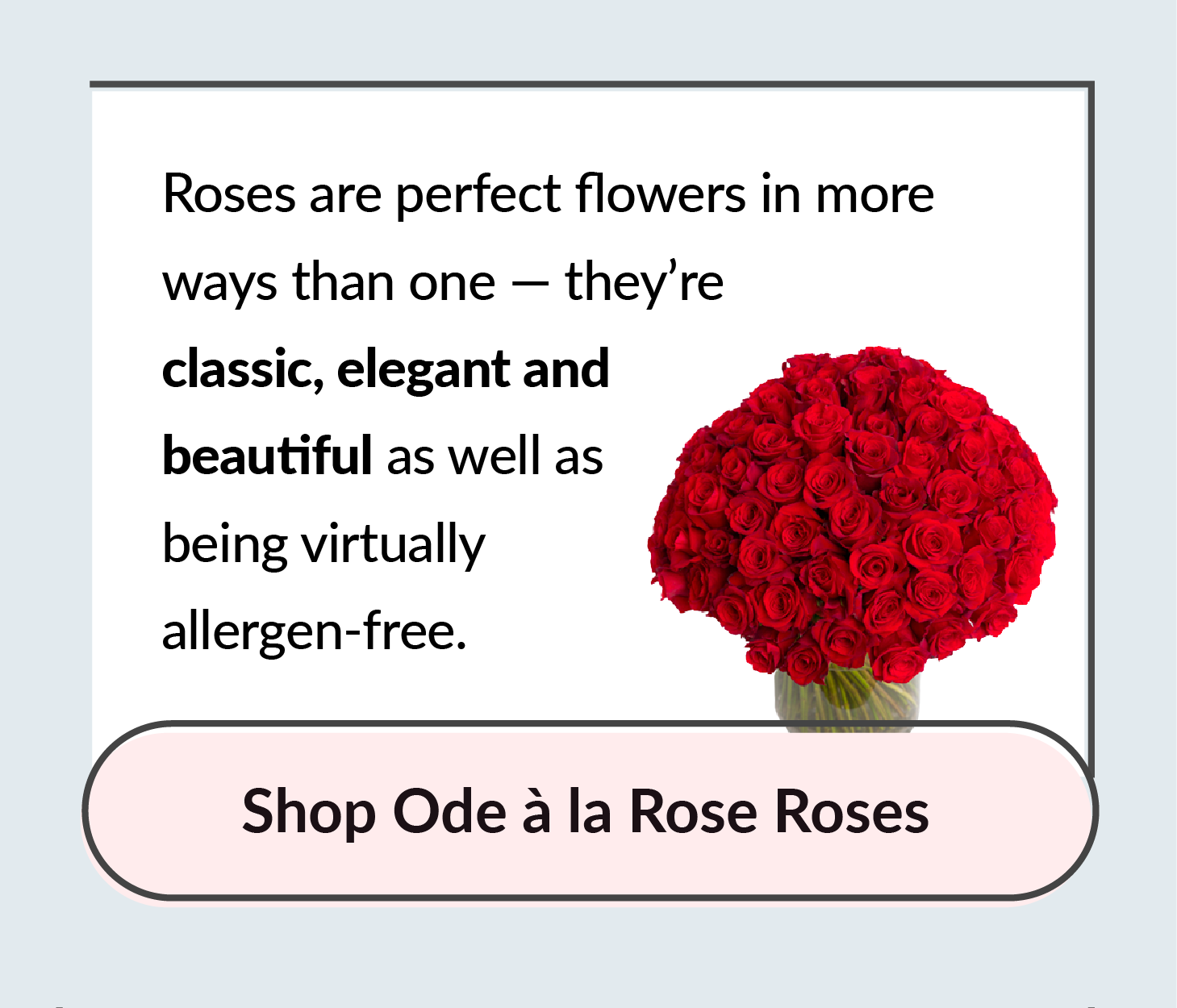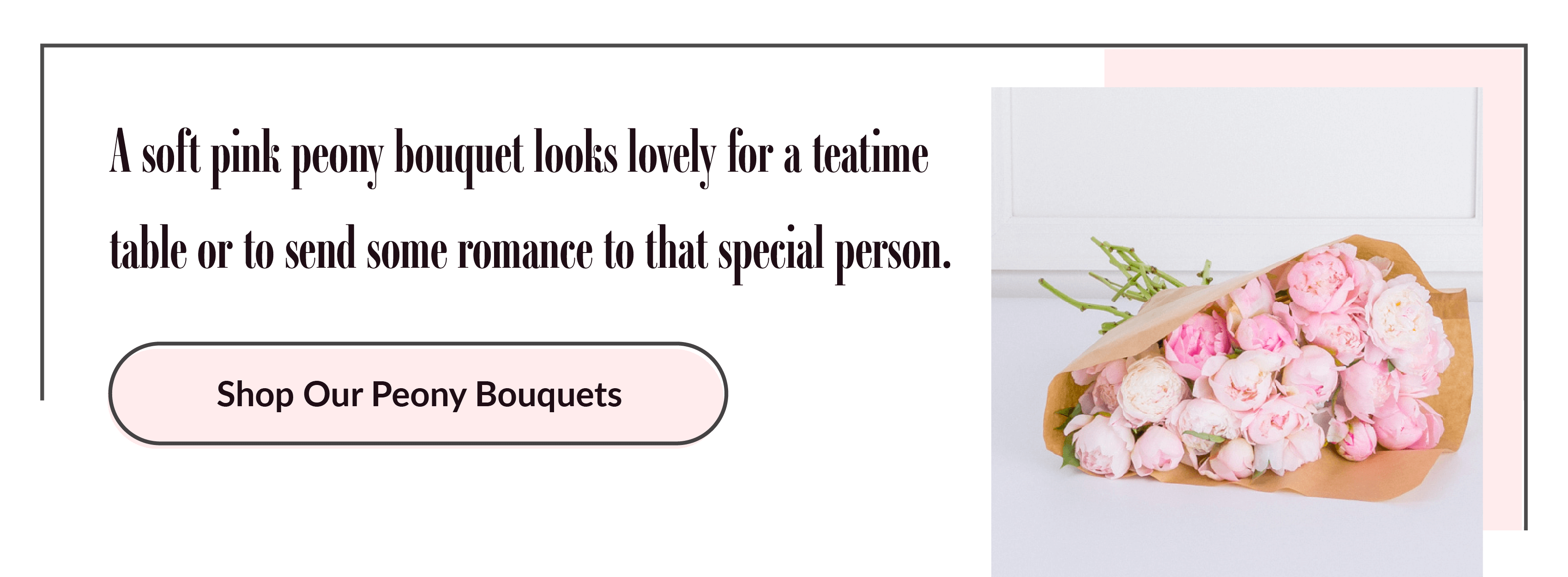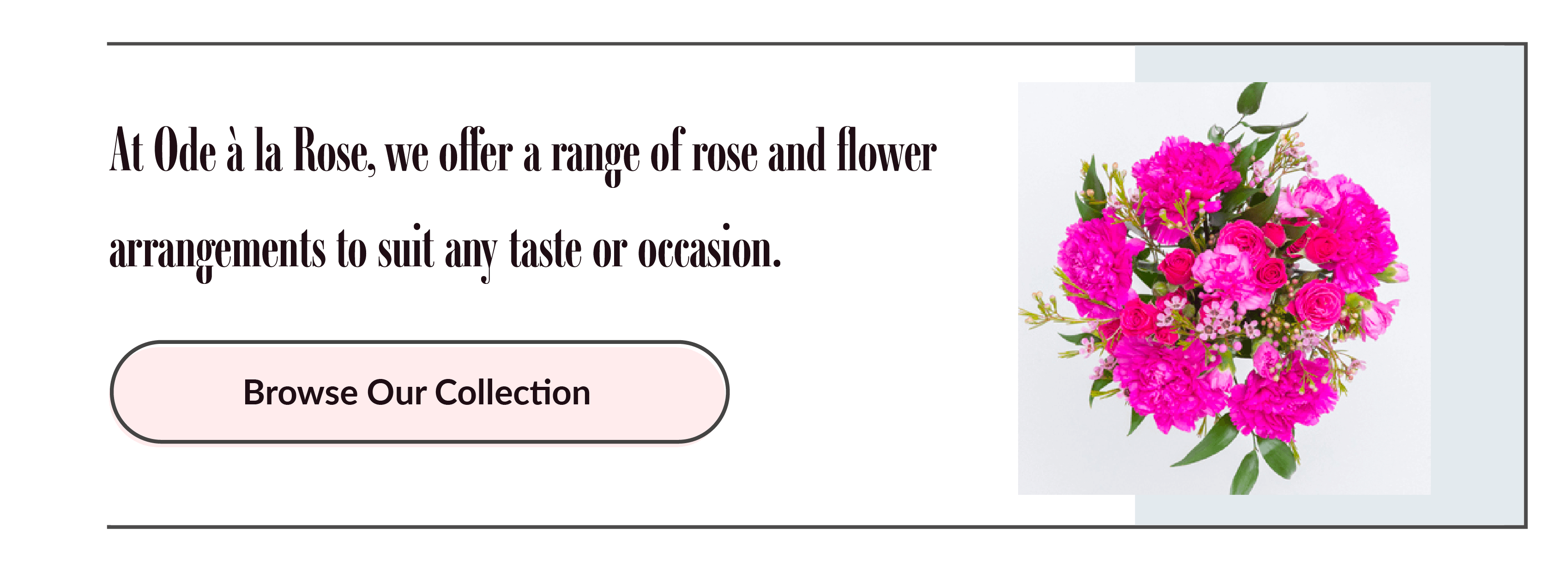When spring arrives, it brings luscious blooms, green grass and bright blue skies. But as fresh flowers emerge from the earth, those with seasonal allergies head back indoors. Basking in the sun is simply not worth the risk of the sneezing, itching and coughing that accompanies pollen allergies. Allergies prevent people from fully enjoying the outdoors, and those with severe pollen allergies may even hesitate to bring cut flowers into their homes.
Luckily, with the right knowledge, you can find beautiful blooms that won’t make you sneeze. Many flower varieties do not irritate pollen allergies, so you can brighten your home with them while avoiding discomfort. Read on for a guide to the best and worst flowers for pollen allergies and how to select the perfect bouquet for your home.
- Best flowers for allergy sufferers
- Perfect bouquet options for allergy sufferers
- Worst flowers for allergy sufferers
- Bouquets allergy sufferers should avoid
- What are pollen allergies?
- Why do flowers irritate allergies?
- Why certain flowers are worse for allergies than others
- Finding the perfect bouquet
Also check out the following posts:
- Which Flowers Last the Longest?
- Which Flowers Smell the Best?
- The Best Flowers for Different Occasions
- Your Myers Briggs Flower Type
The Best Flowers for People With Allergies
Luckily for flower lovers, there are quite a few varieties of flowers that those with pollen allergies can enjoy without experiencing a reaction. Many flowers produce very little pollen, or the pollen they do produce is too heavy to become airborne. Perfect flowers and flowers pollinated by insects can be an excellent choice for allergy sufferers to pluck for bouquets or plant in their gardens.
[slide-anything id=”2143″]
While the daisy family is a nightmare for allergy sufferers, they can find solace in another of the largest families of flowers — the orchid family. Orchids are an exotic and elegant flower that comes in a wide variety of colors. Lilies are another popular flower family that produces little to no irritants for those with pollen allergies.
Below are some lovely flower options for those with allergies:
- Daffodil: These popular springtime blooms give a bright pop to any bouquet. Daffodils are recognizable for their unique, trumpet-like centers and simple yellow petals. They produce very little pollen, which stays contained inside their center cup, making them perfect for allergy sufferers.
- Geranium: Geraniums are simple, five-petaled flowers that allergy sufferers can enjoy in a variety of colors, including pink, white, red, purple and blue. They’re an excellent choice for potted plants, as they feature rich green foliage.
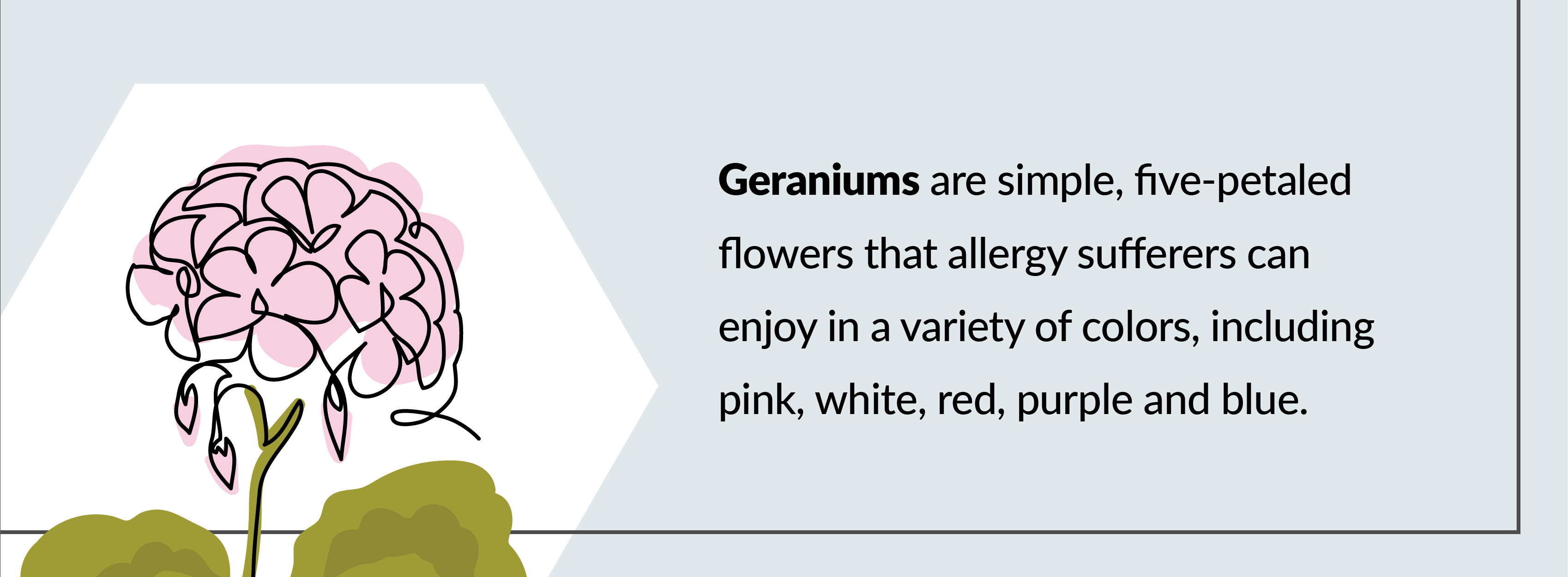
- Hydrangea: Hydrangea bushes produce large, round blooms that are prized for their beautiful pastel colors, such as baby blue, pale pink and lavender. White hydrangeas are also a popular addition to wedding bouquets and can provide fullness in a floral arrangement. Hydrangeas produce very little pollen, making them perfect for allergy sufferers.
- Iris: Irises are known and loved for their deep purple and lavender blooms. Their unique, lily-like shape adds intrigue to traditional bouquets. Irises grow in thin, delicate varieties as well as full flowers with soft, lush blooms. Irises have heavy pollen that’s trapped inside their long petals and unable to harm even the most sensitive of allergy sufferers.
- Lily: Available in many varieties, lilies are recognizable by their large flower heads with distinct petals. Most of them have six petals that can feature unique patterns like speckles and stripes. They typically have heavy pollen that’s carried by insects, so they pose little threat to allergy sufferers. However, some lilies can have a very strong fragrance. If you’re sensitive to strong smells, you may want to opt for a less fragrant option.
- Orchid: Orchids are a popular flower both potted on their own and incorporated into elegant bouquets. They have a sophisticated and modern appeal that makes them a lovely decoration for offices and other sleek spaces. Orchids produce very little pollen, so you can enjoy them without risking an allergic reaction.
- Peony: With their full blooms and deep green leaves, peonies are a favorite for gardens and bouquets. From pale pink to rich raspberry, peonies bring warmth to any arrangement. Their layers of soft petals trap pollen, making them a perfect choice for people with pollen allergies.
- Rose: Roses are perfect flowers in more ways than one — they’re classic, elegant and beautiful as well as being virtually allergen-free. These self-pollinating flowers produce a soft and lovely fragrance without generating airborne pollen. Fill your home with rose bouquets in any color, or send them to someone special.
- Snapdragon: A popular garden flower, snapdragons feature a unique blossom shape and a wide variety of colors. Their pillared blooms provide height and intrigue to floral arrangements. Snapdragon petals enclose the stamen to trap pollen inside, making them perfect for allergy sufferers to enjoy all summer long.
- Sunflowers (hypoallergenic): Luckily for sunflower lovers, several hypoallergenic varieties are available to fill a home or garden with. The Joker is a bright flower with a deep red center that fades into yellow tips. Bicolor sunflowers have a similar coloration to The Joker but feature sharper color separation and rich black centers. Apricot Twist sunflowers feature a warm orange coloring and gold center. Infrared Mix sunflowers have a unique variety of colored blooms with full crimson flowers mixed with golden and white blooms.
- Tulip: Tulips are beloved spring blooms known for their unique cup shape. They’re a member of the lily family, meaning they produce very little pollen. What they do produce is heavy pollen that clings to their distinct stamen. Tulips make a lovely addition to fresh spring bouquets and pair well with peonies and other lilies.
- Zinnia: Zinnias are a dream come true for daisy-lovers that suffer from pollen allergies. While they’re a member of the daisy family, they tend to be more amenable to allergy sufferers. Available in bright pinks, reds, oranges and yellows, zinnias provide a pop of color for gardens and bouquets alike.
While these popular blooms are a great place to start, the list of flowers that are friendly to allergy sufferers doesn’t end there. Others that are great for those with pollen allergies include azalea, begonia, cactus flowers, camellia, chenille, clematis, columbine, crocus, impatiens, pansy, periwinkle, petunia, phlox, salvia, thrift and verbena.
Perfect Bouquets for Allergy Sufferers to Enjoy
Because of the multitude of flowers that do not irritate pollen allergies, it’s easy to find a beautiful floral arrangement that won’t make you sneeze and itch. These lovely bouquets are perfect for allergy sufferers and can be enjoyed year-round without discomfort:
- Rose bouquets: Maybe we’re biased, but we believe you can never go wrong with a bouquet of roses. These classic and elegant flowers are perfect on their own or paired with a variety of other blooms. Rose bouquets can say so many things, from “I love you” to “I miss you” to “Get well soon.” Send a message to someone special with an allergen-free rose bouquet.
- Peony bouquets: A soft pink peony bouquet looks lovely for a teatime table or to send some romance to that special person. Peony bouquets are full and bright, bringing light and color into any space.
- Sleek mixed bouquets: Many flowers that don’t produce allergic reactions are unique and exotic blooms. Pair smooth lilies with fun snapdragons for an interesting and lovely arrangement. Those with allergies don’t need to avoid bouquets with a variety of different flowers, as long as they look for low-pollen options. Consider our modern all-white bouquet of roses, orchids and snapdragons or our classic Emma bouquet with pink peonies, white roses, aster and eucalyptus. For a soft color and fresh mix, choose our Lisette bouquet of quicksand roses, carnations, spray roses, tulips, and delphinium. If you’re looking for a casual bouquet to decorate your home, try a monochrome bouquet in pink, red or white.
- Orchids and orchid bouquets: Orchids make a lovely addition to exotic and classic bouquets, and their sleek form is perfect for modern spaces. Orchids pair beautifully with fresh greens and lilies, but there’s a lovely simplicity to a single orchid that should not be overlooked.
The Worst Flowers for Allergies
Flowers that cause the strongest reactions in allergy sufferers are those with the highest pollen levels or ones that are the most likely to release pollen into the air. Generally, any flower that’s in the Asteraceae family will not be a great choice for those with pollen allergies. The Asteraceae, or Compositae, family is commonly referred to as the daisy, aster, composite or sunflower family.
These flowers are characterized by their large, circular centers and petals that fan out in a circle. They’re often called “composite” because the flower head is actually made up of hundreds of tiny flowers that are closely packed together. While most flowers in the aster family are not wind-pollinated, they tend to have very high pollen levels and cause irritation for those with pollen allergies.
Other flowers that cause reactions for allergy sufferers are varieties that you might encounter in the wild, such as pigweed, goldenrod and jasmine vine. If you suffer from pollen allergies, you should prune these flower varieties from your garden and avoid bouquets with them.
Below are some common flowers that those with pollen allergies should avoid:
- Baby’s breath: These tiny white flowers pack a big allergy punch. Baby’s breath is known and loved for its thin and delicate structure and usefulness for filling out bouquets and floral wreaths. If you want to incorporate baby’s breath into a floral arrangement without the allergic reaction, look for double flowers. Double-flowered baby’s breath is a hybridized variety, meaning it naturally produces less pollen. The double flowers also have more petals that help to trap pollen and prevent it from becoming airborne.
- Chamomile: Chamomile flowers are small white flowers with yellow centers that are a member of the daisy family. Chamomile flowers are most familiar in chamomile tea. They produce a lot of pollen and can still contain some irritants when they’re dried and steeped into tea. Those with severe pollen allergies may even experience mild reactions when enjoying the hot beverage.
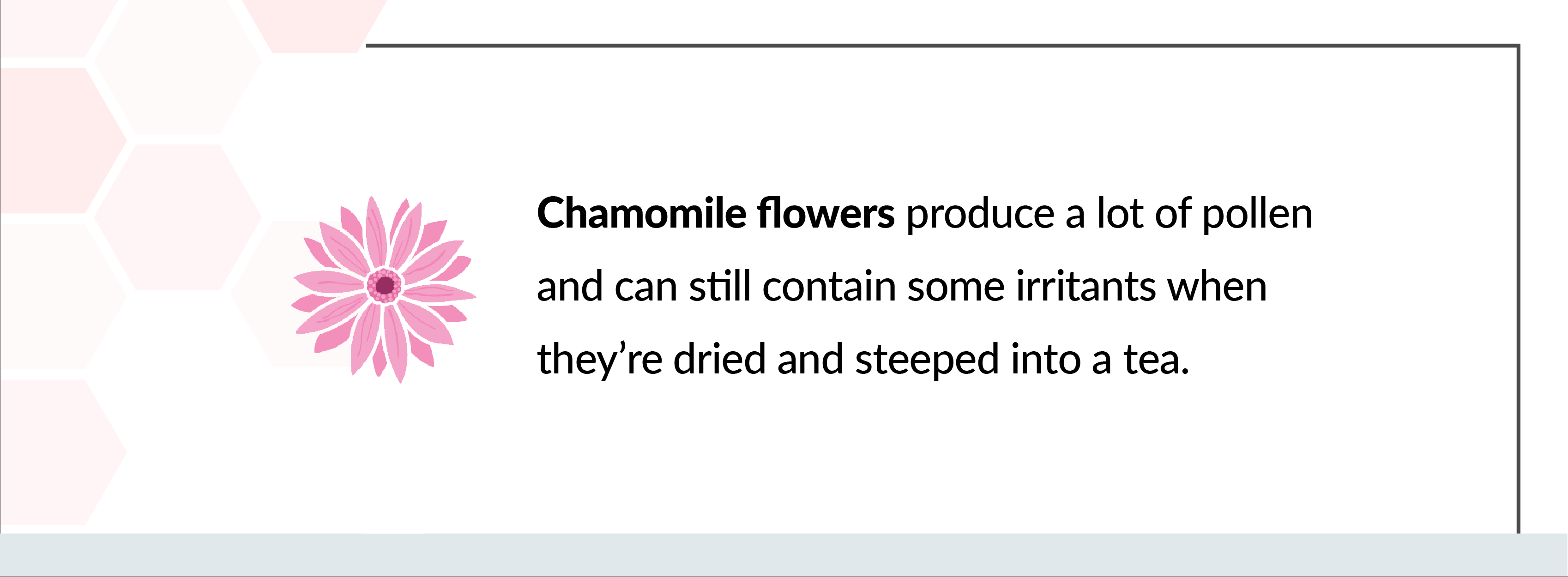
- Chrysanthemums: Another daisy family favorite, chrysanthemums feature warm, earthy colors like burgundy, orange, raspberry and yellow. Their full, bushy structure makes them perfect for potted plants and outdoor decorations. Chrysanthemum plants often have a high concentration of flower heads, meaning a higher concentration of pollen. Because they bloom in late summer and early fall, chrysanthemums can drag allergy season well into the cooler autumn months.
- Dahlia: Dahlia flowers are another popular variety of the daisy family, loved for their vibrant colors and distinct petals. With over 40 different species, dahlias can range from round and full to delicate with long, pointed petals. While dahlias attract pollinating insects well due to their brightness, they still produce a lot of pollen that can be very irritating for those with allergies. If you adore dahlias but suffer from pollen allergies, consider trying a hybrid variety instead.
- Daisy: Daisies are not wind-pollinated but are very high pollen producers. With their iconic yellow center and white petals, daisies are popular in gardens and bouquets. They’re very easy to cultivate and bloom throughout the summer months.
- Gerbera daisy: Gerbera daisies are one of the brightest varieties in the daisy family and are very popular as potted flowers. While they’re lovely and colorful, they’re best to avoid if you suffer from pollen allergies.
- Sunflowers: A classic symbol of summer, sunflowers are recognizable by their large center disk and bright yellow petals. With some varieties growing up to 10 feet tall, sunflowers are popular in flower gardens. They can also add a pop of color to bouquets and floral arrangements. However, the large centers of sunflower heads are loaded with pollen that can cause serious irritation for allergy sufferers. If you love sunflowers but experience pollen allergies, don’t despair. Hypoallergenic varieties produce less pollen and can be safely enjoyed by lovers of the bright summer blooms.
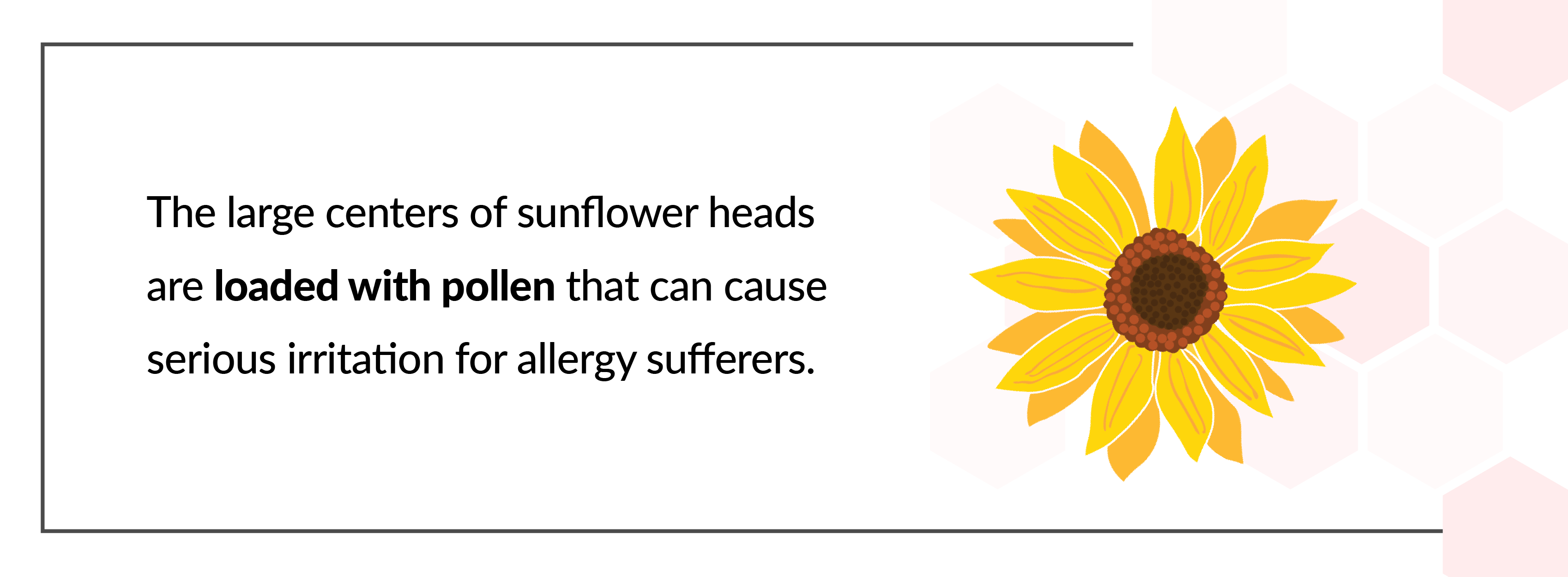
Bouquets Allergy Sufferers Should Avoid
Whether you’re wooing a love interest or sending flowers for Mother’s Day, you don’t want to send a case of the sniffles along with your beautiful bouquet. Keep allergies in mind when sending flowers to that special someone, and stay away from arrangements with flowers that tend to irritate pollen allergies. Here are some common bouquets to avoid if you or your loved one suffers from pollen allergies:
- Bouquets with daisies: Flower arrangements with any variety of daisies should be avoided, from a colorful collection or Gerbera daisies to a simple bouquet of classic garden daisies.
- Sunflower bouquets: Bouquets with sunflowers are bright and lovely but should be avoided if you suffer from pollen allergies. Because of their size, sunflowers are typically the centerpiece flower of any bouquet they’re in. This quality means that sunflowers are often paired with delicate filler flowers, such as baby’s breath or goldenrod. Unfortunately, these flowers also irritate allergies, making sunflower bouquets a potent pollen producer. If you’re lucky enough to be allergy-free, we recommend sunflower bouquets as a centerpiece for your summer table or a lovely addition to your windowsill.
- Bouquets with baby’s breath or other fillers: Many mixed bouquets incorporate delicate baby’s breath or other light flowers that complement the prominent blooms. Be careful when purchasing bouquets with a lot of fillers or wildflowers, as they may trigger allergies. If you don’t suffer from pollen allergies, arrangements with wildflowers can be a lovely addition to your home or gift for that special someone. Consider our sophisticated Wildflowers & Rose Bouquet or Felice arrangement.
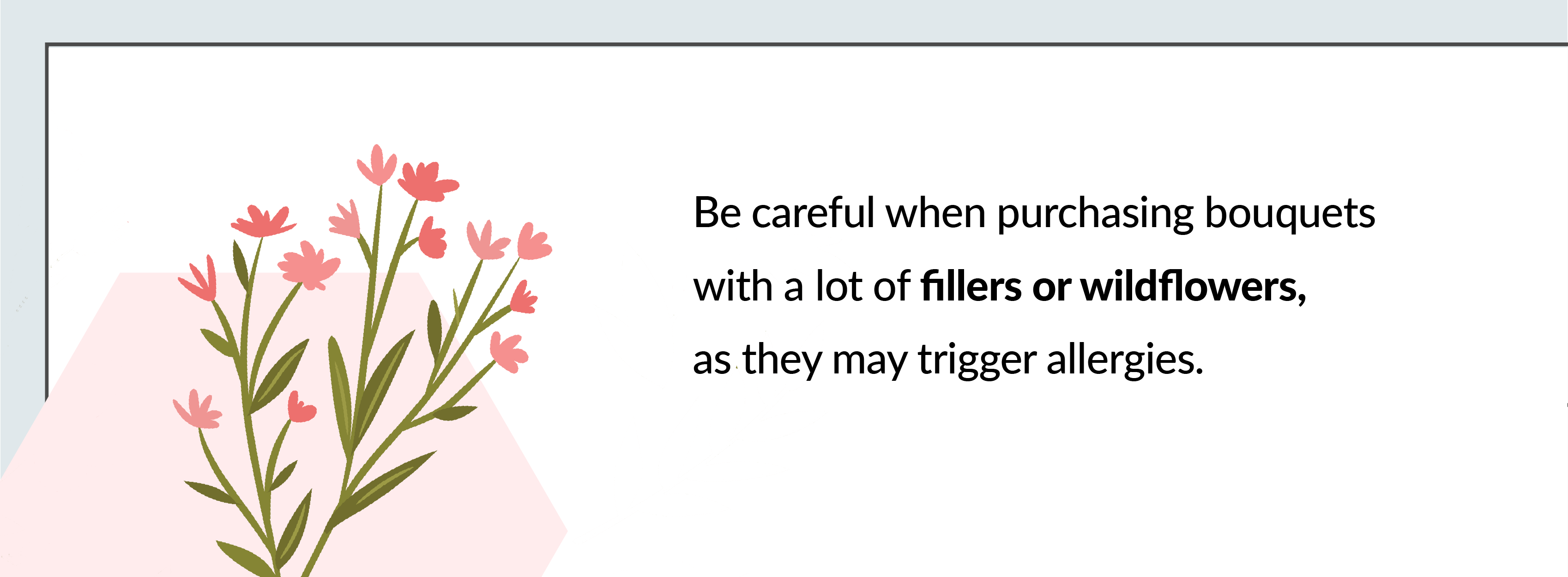
What Are Pollen Allergies?
Pollen is an essential part of a functioning ecosystem, as it allows flowers and other plants to reproduce. For those with allergies, it can be a major annoyance. When fine pollen powder is stirred into the air and inhaled, those with pollen allergies experience an adverse reaction. Their bodies treat the harmless pollen like a foreign invader and produce histamine to fight back. This immune response is what causes the uncomfortable symptoms associated with pollen allergies.
Pollen allergies are one of the most common allergies, with more than 25 million Americans affected. Most people experience pollen allergies seasonally — when plants are in bloom — in the spring, summer or fall. This issue is commonly known as “hay fever.”
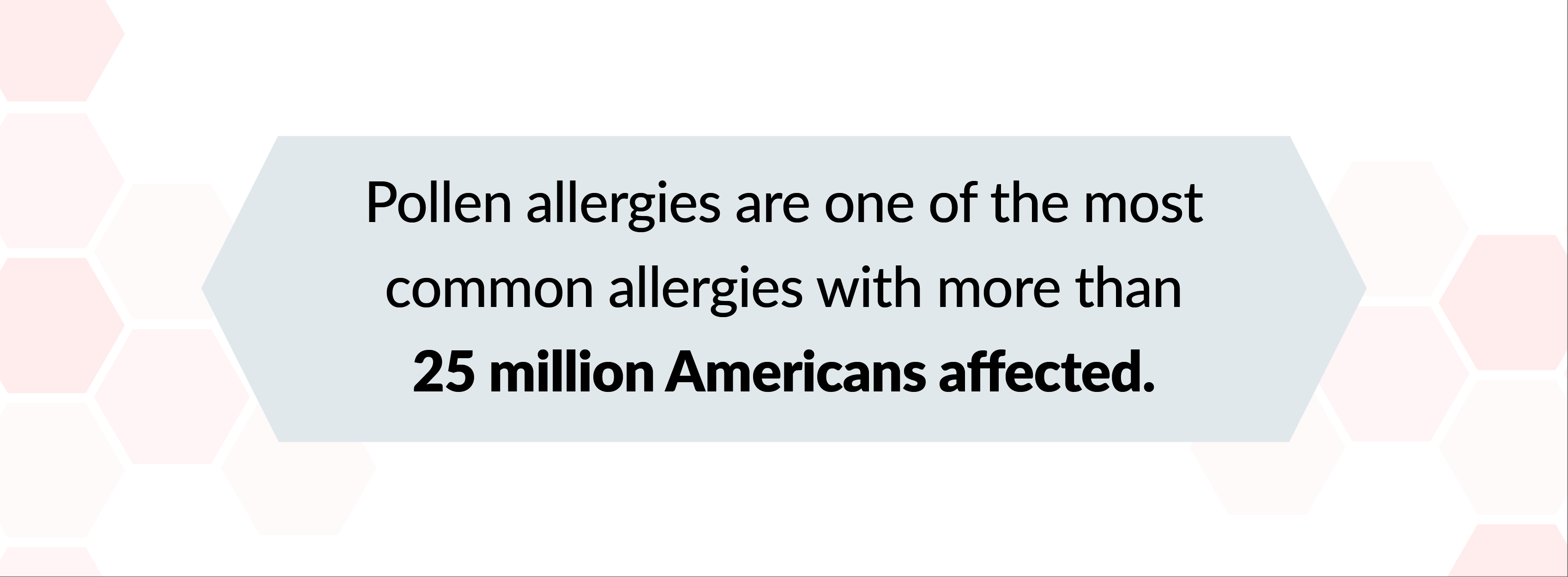
Those with more severe allergies may experience them year-round. Common symptoms of pollen allergies include a runny or stuffy nose, watery and itchy eyes, an itchy throat and coughing. A person with a pollen allergy may also be more allergic to a specific type of pollen, such as tree pollen, grass pollen or ragweed pollen.
Even during heavy-pollen seasons, the amount of pollen in the air varies from day to day. Dry, warm and windy days tend to have higher pollen counts, leading to more severe allergic reactions. Pollen is less likely to become airborne on wet, rainy and cool days, meaning allergy sufferers are safe to roam outdoors. The daily weather report will often list the pollen count during spring, summer and fall.
Why Do Flowers Irritate Allergies?
Any plant that produces pollen poses a threat for an allergy sufferer. Trees, grasses and ragweed are the most common causes of pollen allergies, but flower pollen can also cause irritation, particularly in the spring and summer. Flowers with very light pollen that can be easily stirred up by the breeze are more likely to irritate allergies.
Some flowers produce more pollen than others, which also makes them more likely to cause allergic reactions. When flowers are brought inside, pollen can become more concentrated in the smaller area and produce an even more severe reaction. For most people, it’s the pollen itself that causes an allergic reaction, but for others, the strong fragrance of some flowers can cause adverse effects like headaches.
Why Are Some Flowers Worse for Allergies Than Others?
Determining which flowers will cause the worst allergic reactions has to do with the gender of the plant, as only male flowers produce pollen. Some plants contain all male or all female flowers on each individual plant. These flowers, called dioecious, rely on wind or insects to carry pollen from a male plant to a female plant to reproduce.
Other plants, called monoecious plants, contain both male and female flowers on the same plant, meaning that pollen must travel from flower to flower but not from plant to plant. Some monoecious plants contain male and female parts in the same flower. They’re often called “perfect flowers” and do not require pollen to be transferred at all, as a single flower can reproduce on its own.
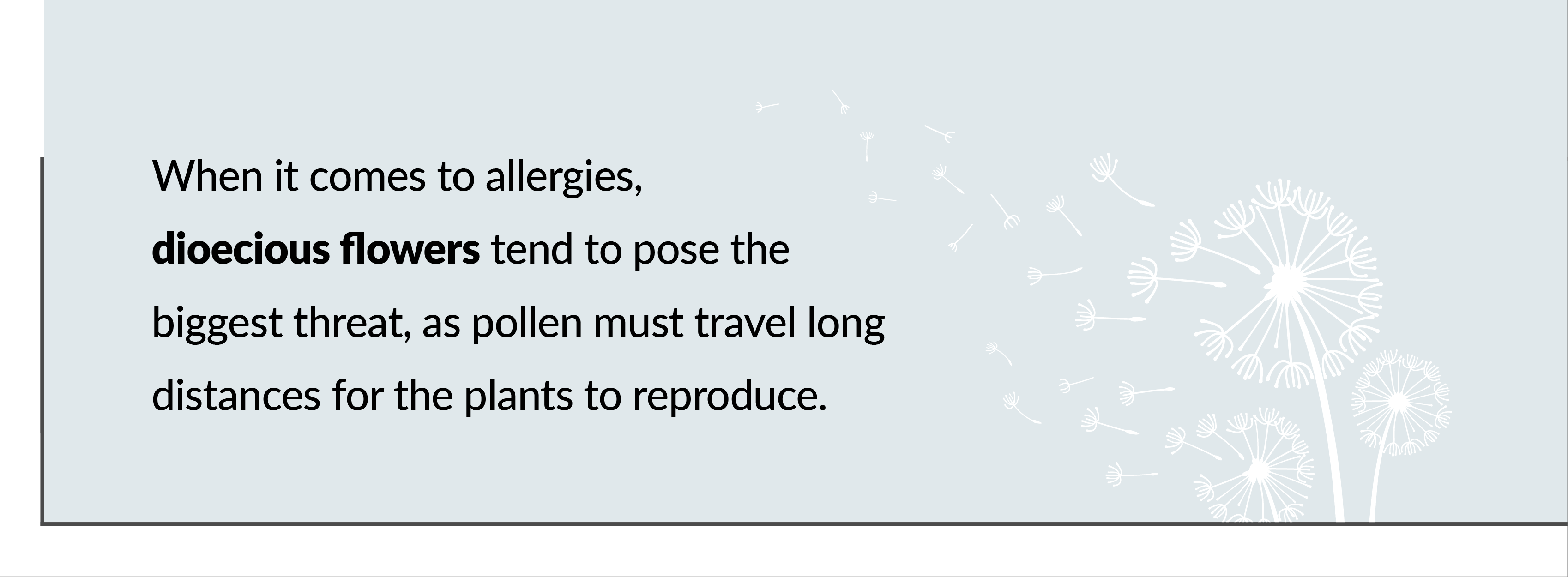
When it comes to allergies, dioecious flowers tend to pose the biggest threat, as pollen must travel long distances for the plants to reproduce. As pollen is carried from flower to flower, some is inevitably dispersed into the air. Monoecious flowers can also cause reactions for allergy sufferers when the pollen travels between flowers. Perfect flowers are the best option for allergy sufferers, as they produce little to no pollen.
Other flowers that tend to produce less pollen are those that are large or flashy. Big and bright flowers attract bees more easily, so they don’t need to rely on wind for pollination. These flowers also tend to have heavier pollen that doesn’t become airborne as easily. Hybridized plants usually produce less pollen as well and can be a great option for allergy sufferers.
Find Your Perfect Bouquet at Ode à la Rose
With a little floral knowledge, even those with serious pollen allergies can fill their homes and gardens with luscious and bright blooms. From lilies and orchids to peonies and roses, allergy sufferers have many lovely flowers to choose from. At Ode à la Rose, we offer a range of rose and flower arrangements to suit any taste or occasion, so you can impress that special someone without triggering sneezes and coughs.
All of our high-quality roses are sourced from the best farms around the world, and every arrangement is prepared by our expert floral designers. Whether you’re sending apologies and condolences or love and congratulations, we have the perfect flower arrangement for you. When you order from Ode à la Rose, we’ll ship your order in our signature purple gift box to ensure your flowers arrive fresh and in the best condition. If you want to fill your home with the joy of flowers, browse our collection of beautiful, Parisian-inspired bouquets today.
Disclaimer: Ode à la Rose is a nationwide flower delivery service. We deliver to every city in the US. Same-day flower delivery is available in select cities: NYC, Chicago, Philadelphia, Los Angeles, Austin, Washington D.C., and Miami. Next-day delivery is available everywhere else in all the US. For flowers delivered to New York City, shop from our same-day delivery section.
